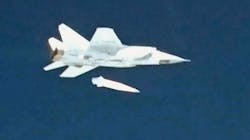WASHINGTON – In January 2019, Chinese Communist Party leaders announced that the newest iteration of their DF-17 hypersonic weapons system was being designed to overwhelm and sink U.S. aircraft carriers and surface combatants stationed in the West Pacific. The Maritime Executive reports. Continue reading original article
The Military & Aerospace Electronics take:
24 April 2019 -- According to official statements from the People’s Liberation Army Rocket Force (PLARF), a targeted salvo of eight hypersonic glide vehicles (HGVs) set aloft by DF-17s would swamp close-in point defenses and annihilate surface vessels through incredible transfers of kinetic energy.
This type of inflammatory language is not new and Chinese officials have been known to exaggerate the capabilities of their military. However, discussion of the DF-17 and similar weapon systems as conventional, theater-level assets, rather than the strategic nuclear capabilities generally associated with hypersonic missiles, poses a set of very serious and immediate threats to decision-makers in Washington.
Rather than continue the popular trend of treating hypersonic weapons primarily as delivery mechanisms for nuclear warheads aimed at strategic targets, China has been quick to use the technology to augment its theater-level Anti-Access/Area Denial (A2AD) capabilities.
Related: Developing enabling technologies for hypersonic weapons and missile defense
Related: Why is Navy weapons development moving so quickly? Just look to the South China Sea
John Keller, chief editor
Military & Aerospace Electronics
Ready to make a purchase? Search the Military & Aerospace Electronics Buyer's Guide for companies, new products, press releases, and videos

